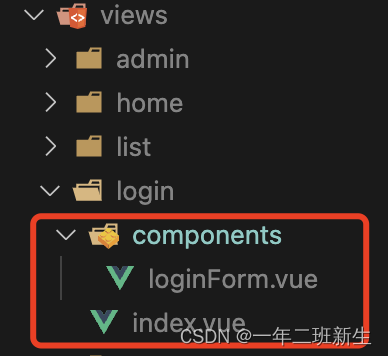在第四篇中我们学习了
mixin公共方法封装,VueRouter的使用以及配置权限路由,本期我们将讲述Pinia,并使用Pinia和Axios接口数据完成登录功能以权限路由改造
本期需要掌握的知识如下:
Pinia在项目中的使用及持久化- 使用
Pinia和Axios完成登录功能 - 使用
Pinia完成对权限路由改造
1. Pinia 安装及使用
$ npm install pinia 安装pinia
$ npm i pinia-plugin-persist --save 安装pinia 持久化插件
main.js 引入 pinia
import {
createApp } from 'vue'
import './style.css'
import App from './App.vue'
import router from './router'
// pinia 部分
import {
createPinia } from 'pinia';
import piniaPersist from 'pinia-plugin-persist'
const pinia = createPinia()
pinia.use(piniaPersist)
import ElementPlus from 'element-plus'
import 'element-plus/dist/index.css'
import zhCn from 'element-plus/dist/locale/zh-cn.mjs'
import 'nprogress/nprogress.css'
import axios from 'axios'
import VueAxios from 'vue-axios'
createApp(App).use(router).use(pinia).use(ElementPlus, {
locale: zhCn }).use(VueAxios, axios).mount('#app')
scr目录下新建 store目录,并在该目录下新建 index.js

import {
defineStore } from "pinia"
/**
* 这个 第一个参数main,也称为 id,是必要的,Pinia 使用它来将 store 连接到 devtools。
* 将返回的函数命名为use...(更好的语义化) 是跨可组合项的约定,以使其符合你的使用习惯。
*/
export const useStore = defineStore('user', {
state() {
return {
current_userInfo: {
id: '',
username: '',
password: '',
isOpen: '',
apiToken: ''
},
animationRoute: [],
}
},
/**
* 用来封装计算属性 有缓存功能 类似于computed
*/
getters: {
getNum(state) {
return `我是一个计数器${
state.count}`
}
//或者不使用state传递参数直接使用this
//getNum(){
// return `我是一个计数器${this.count}`
// }
},
/**
* 编辑业务逻辑 类似于methods
*/
actions: {
SAVE_USER_MESSAGE(val) {
this.current_userInfo = val
},
SAVE_ANIMATION_ROUTER(val) {
this.animationRoute = val
}
},
persist: {
enabled: true, // 开启数据缓存
strategies: [
{
key: 'user',//存储key值
storage: localStorage, // 默认是sessionStorage
}
],
}
})
Pinia 解释说明:
state相当于vuex中的datagetters等同于vuex的gettersactions相当于vuex中的methods、actions的和persist持久化数据配置,防止 Pinia刷新后数据丢失- Pinia 中是可以使用
this关键字
2.登录功能实现
1.创建用户JSON文件和动态路由文件
 ·
·
// user.json
{
"data": [
{
"id": 1,
"username": "admin",
"password": "123456",
"isOpen": "true",
"apiToken": "token_assets"
}
]
}
// router.json
{
"data": [
{
"name": "admin",
"path": "/admin",
"hidden": false,
"meta": {
"title": "首页"
},
"children": [
{
"name": "admin/user",
"path": "user",
"hidden": false,
"meta": {
"title": "用户管理"
}
},
{
"name": "admin/role",
"path": "role",
"hidden": false,
"meta": {
"title": "角色管理"
}
}
]
}
],
"code": 200
}
2.创建 api 请求接口

// login.js
import request from '@/utils/request'
export const handleLogin = () => {
return request({
url: 'user.json',
method: 'GET'
})
}
// common.js
import request from '@/utils/request'
// 获取动态路由接口
export const animationRoute = () =>{
return request({
url:'router.json',
method:'GET'
})
}
3.页面搭建及接口请求
目录结构如下
index.vue为父组件components目录下的loginForm.vue为子组件,包括Form表单
这样做的原因是:
- 减少每个页面的代码,使代码更简洁、方便后期维护
- 复习
组件传值

index.vue 代码
<template>
<div class="login">
<loginForm @LoginEmit="LoginEmit" />
</div>
</template>
import {
defineComponent, onMounted, ref } from 'vue'
import {
useRouter } from 'vue-router'
import {
ElMessage } from 'element-plus'
// 引入 pinia 方法
import {
useStore } from '@/store/index.js'
// 引入 登录 api
import {
handleLogin } from '@/api/login.js'
// 引入 权限路由 api
import {
animationRoute } from '@/api/common.js'
// 引入 登录表单子组件
import loginForm from './components/loginForm.vue'
// 注册组件
const Component = defineComponent({
loginForm
})
/**
* @type data
* @description 所有数据都在此体现
* **/
const Router = useRouter()
const store = useStore()
/**
* @type methods
* @description 所有方法、事件都在此层中体现
* **/
// 登录按钮方法 由子组件触发并携带参数
const LoginEmit = async form => {
const {
username, password } = form
let res = await handleLogin()
// 以下三行代码是判断登录账号密码是否正确
let currentUser = res.data.filter(item => {
return item.username === username })
if (currentUser.length < 1) return ElMessage.error('用户不存在')
if (currentUser[0].password !== password) return ElMessage.error('密码错误')
// 确保登录成功后 调用 Pinia 方法存储用户信息
store.SAVE_USER_MESSAGE(currentUser[0])
// 获取 权限路由
let routerList = await animationRoute(username)
// 调用 Pinia 存储权限路由方法 将路由信息存储到 store中
store.SAVE_ANIMATION_ROUTER([...routerList.data])
// 跳转到 首页
Router.push('/home')
}
表单组件
<template>
<div class="login-form">
<div class="title">用户登录</div>
<div class="login_content">
<el-form ref="ruleLogin" :model="loginForm" :rules="rules">
<el-form-item label="账号:" prop="username">
<el-input v-model="loginForm.username" autocomplete="off" placeholder="请输入账号" />
</el-form-item>
<el-form-item label="密码:" prop="password">
<el-input v-model="loginForm.password" type="password" autocomplete="off" placeholder="请输入密码" />
</el-form-item>
</el-form>
<el-button type="primary" @click="handleLogin">登录</el-button>
</div>
</div>
</template>
import {
ref } from 'vue'
/**
* @type data
* @description 所有数据都在此体现
* **/
const loginForm = ref({
username: '',
password: ''
})
const ruleLogin = ref(null)
const rules = {
username: {
required: true, message: "账号不可为空", trigger: "blur" },
password: {
required: true, message: "密码不可为空", trigger: "blur" },
}
/**
* @type methods
* @description 所有方法、事件都在此层中体现
* **/
const emit = defineEmits(['LoginEmit'])
// 登录按钮点击事件
const handleLogin = async () => {
try {
// 先判断表单校验是否通过,再去触发 父组件方法并传参
await ruleLogin.value.validate()
// 触发父组件登录方法
emit('LoginEmit', loginForm.value)
} catch (err) {
}
}
4.权限路由改造
import {
createRouter, createWebHistory } from 'vue-router'
import {
homeRoutes } from './modules/home'
import {
loginRoutes } from './modules/login'
import {
getlocalstroage, clearSession, clearLocal, showNprogress, hideNprogress } from '@/mixin'
import {
useStore } from '@/store'
import {
storeToRefs } from "pinia"
// 首先把你需要动态路由的组件地址全部获取
let modules = import.meta.glob('../views/**/*.vue')
let flag = true
const router = createRouter({
history: createWebHistory(),
routes: [...loginRoutes, ...homeRoutes]
})
router.beforeEach((to, from, next) => {
showNprogress()
if (to.meta.title) {
document.title = to.meta.title
}
const {
animationRoute } = storeToRefs(useStore())
addDynamicRoute(animationRoute.value)
if (animationRoute.value.length > 0) {
if (flag) {
const NotFound = {
path: '/:pathMatch(.*)*', redirect: '/404' }
router.addRoute(NotFound)
next({
...to, replace: true })
router.options.routes.push(JSON.parse(JSON.stringify(...animationRoute.value),NotFound))
flag = false
}
}
if (to.path != '/login') {
let apiToken = getlocalstroage('user') ? JSON.parse(getlocalstroage('user'))?.current_userInfo?.apiToken : null
if (!apiToken) {
clearSession()
clearLocal()
next('/login')
}
}
next()
})
router.afterEach(() => {
hideNprogress()
})
// 添加动态路由,parent默认为home是首页最外层的路由name名
const addDynamicRoute = (useroute, parent) => {
for (let i = 0; i < useroute.length; i++) {
if (useroute[i].children && useroute[i].children.length > 0) {
router.addRoute({
name: useroute[i].name, path: useroute[i].path, component: modules[`../views/${
useroute[i].name}/index.vue`], meta: {
title: useroute[i].meta.title }, hidden: useroute[i].hidden })
// 递归添加动态路由
addDynamicRoute(useroute[i].children, useroute[i].name);
} else {
router.addRoute(parent, {
path: useroute[i].path, component: modules[`../views/${
useroute[i].name}/index.vue`], meta: {
title: useroute[i].meta.title }, hidden: useroute[i].hidden })
}
}
};
export default router